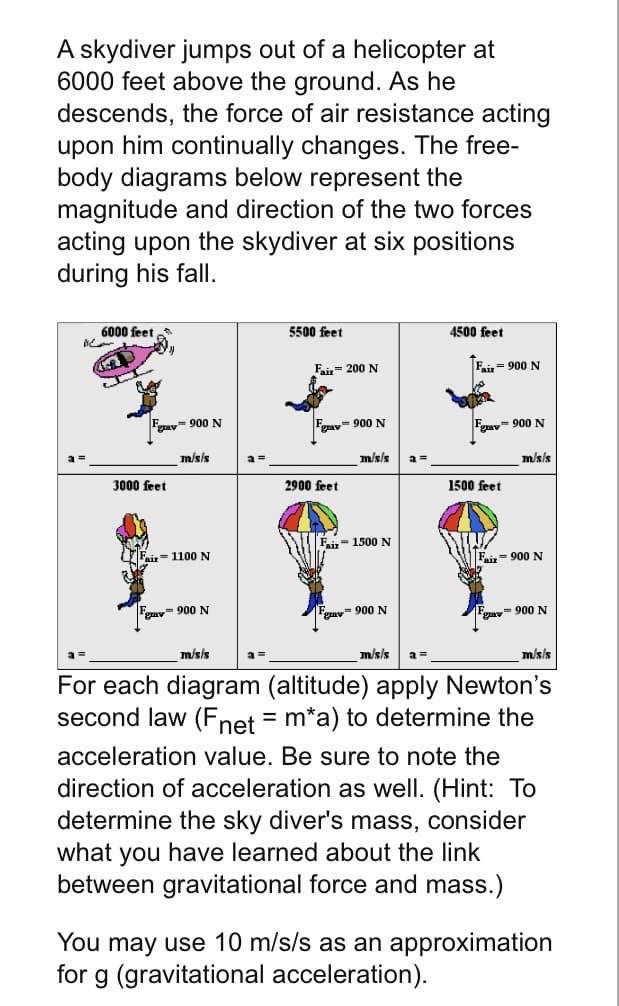Please use the image below to answer these questions 1. Considering the air resistance problem. What is the acceleration altitude of 2900ft? Show all work and be sure to include units(including directions) 2. At which altitude (s) has the skydiver reached terminal velocity? How do you know? 3. At 2900 feet, the skydiver is ——. Mark all that apply a) moving upward B) speeding up C) moving downward D) slowing down.
Please use the image below to answer these questions 1. Considering the air resistance problem. What is the acceleration altitude of 2900ft? Show all work and be sure to include units(including directions) 2. At which altitude (s) has the skydiver reached terminal velocity? How do you know? 3. At 2900 feet, the skydiver is ——. Mark all that apply a) moving upward B) speeding up C) moving downward D) slowing down.
University Physics Volume 1
18th Edition
ISBN:9781938168277
Author:William Moebs, Samuel J. Ling, Jeff Sanny
Publisher:William Moebs, Samuel J. Ling, Jeff Sanny
Chapter5: Newton's Law Of Motion
Section: Chapter Questions
Problem 57P: Two teams of nine members each engage in tug-of-war. Each of the first team’s members has an average...
Related questions
Question
100%
Please use the image below to answer these questions
1. Considering the air resistance problem. What is the acceleration altitude of 2900ft? Show all work and be sure to include units(including directions)
2. At which altitude (s) has the skydiver reached terminal velocity? How do you know?
3. At 2900 feet, the skydiver is ——. Mark all that apply
a) moving upward
B) speeding up
C) moving downward
D) slowing down.

Transcribed Image Text:A skydiver jumps out of a helicopter at
6000 feet above the ground. As he
descends, the force of air resistance acting
upon him continually changes. The free-
body diagrams below represent the
magnitude and direction of the two forces
acting upon the skydiver at six positions
during his fall.
MC
6000 feet
CR
C
Fguv
3000 feet
-900 N
m/s/s
Fair=1100 N
grav=900 N
m/s/s
a=
5500 feet
Fair 200 N
Fay=900 N
2900 feet
m/s/s a=
Faiz-1500 N
900 N
4500 feet
Fair= 900 N
v-900 N
1500 feet
m/s/s
Fair-900 N
gav 900 N
m/s/s a=
For each diagram (altitude) apply Newton's
second law (Fnet = m*a) to determine the
acceleration value. Be sure to note the
direction of acceleration as well. (Hint: To
determine the sky diver's mass, consider
what you have learned about the link
between gravitational force and mass.)
m/s/s
You may use 10 m/s/s as an approximation
for g (gravitational acceleration).
Expert Solution
This question has been solved!
Explore an expertly crafted, step-by-step solution for a thorough understanding of key concepts.
Step by step
Solved in 4 steps with 4 images

Knowledge Booster
Learn more about
Need a deep-dive on the concept behind this application? Look no further. Learn more about this topic, physics and related others by exploring similar questions and additional content below.Recommended textbooks for you

University Physics Volume 1
Physics
ISBN:
9781938168277
Author:
William Moebs, Samuel J. Ling, Jeff Sanny
Publisher:
OpenStax - Rice University

Principles of Physics: A Calculus-Based Text
Physics
ISBN:
9781133104261
Author:
Raymond A. Serway, John W. Jewett
Publisher:
Cengage Learning

College Physics
Physics
ISBN:
9781938168000
Author:
Paul Peter Urone, Roger Hinrichs
Publisher:
OpenStax College

University Physics Volume 1
Physics
ISBN:
9781938168277
Author:
William Moebs, Samuel J. Ling, Jeff Sanny
Publisher:
OpenStax - Rice University

Principles of Physics: A Calculus-Based Text
Physics
ISBN:
9781133104261
Author:
Raymond A. Serway, John W. Jewett
Publisher:
Cengage Learning

College Physics
Physics
ISBN:
9781938168000
Author:
Paul Peter Urone, Roger Hinrichs
Publisher:
OpenStax College

Glencoe Physics: Principles and Problems, Student…
Physics
ISBN:
9780078807213
Author:
Paul W. Zitzewitz
Publisher:
Glencoe/McGraw-Hill

College Physics
Physics
ISBN:
9781305952300
Author:
Raymond A. Serway, Chris Vuille
Publisher:
Cengage Learning

College Physics
Physics
ISBN:
9781285737027
Author:
Raymond A. Serway, Chris Vuille
Publisher:
Cengage Learning